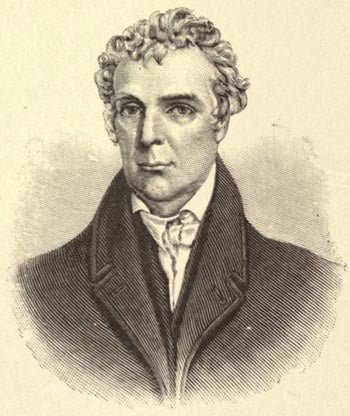Cane Ridge Revival, America
1801 August – Barton Stone

Barton Stone
Impressed by the revivals in 1800, Barton Stone, a Presbyterian minister, organized similar meetings in 1801 in his area at Cane Ridge, northeast of Lexington. A huge crowd of approximately 12,500 attended in more than 125 wagons, including people from Ohio and Tennessee.
At that time, Lexington, the largest town in Kentucky, contained less than 1,800 citizens. Presbyterian, Methodist, and Baptist preachers and circuit riders formed preaching teams, speaking simultaneously in different parts of the campgrounds, all aiming for conversions.
The Cane Ridge Revival
James Finley, later a Methodist circuit rider, described it:
The noise was like the roar of Niagara. The vast sea of human beings seemed to be agitated as if by a storm. I counted seven ministers, all preaching at one time, some on stumps, others in wagons and one standing on a tree which had, in falling, lodged against another. … I stepped up on a log where I could have a better view of the surging sea of humanity.
The scene that then presented itself to my mind was indescribable. At one time I saw at least five hundred swept down in a moment as if a battery of a thousand guns had been opened upon them, and then immediately followed shrieks and shouts that rent the very heavens (Pratney 1994, 104).
Referring to the same gathering, the Rev. Moses Hoge wrote:
The careless fall down, cry out, tremble, and not infrequently are affected with convulsive twitchings….
Nothing that imagination can paint, can make a stronger impression upon the mind, than one of those scenes. Sinners dropping down on every hand, shrieking, groaning, crying for mercy, convulsed; professors praying, agonizing, fainting, falling down in distress for sinners or in raptures of joy! …
As to the work in general there can be no question but it is of God. The subject of it, for the most part are deeply wounded for their sins, and can give a clear and rational account of their conversion (Christian History 1989, 26).
Revival in the early nineteenth century not only impacted the American frontier, but also towns and especially colleges. One widespread result in America, as in England, was the formation of missionary societies to train and direct the large numbers of converts who were filled with missionary zeal.
That Second Great Awakening produced the modern missionary movement and its societies, Bible societies, promoted the abolition of slavery, and initiated many other social reforms. The Napoleonic Wars in Europe (1803–15) and the American War of 1812 with England (1812–15) dampened revival zeal, but caused many to cry out to God for help, and fresh stirrings of revival continued after that, especially with Charles G. Finney.
© Geoff Waugh. Used by permission.
For further research:
The Cane Ridge Revival



